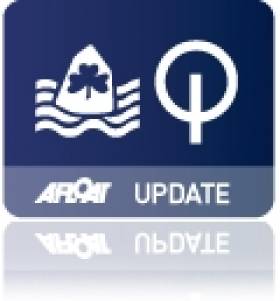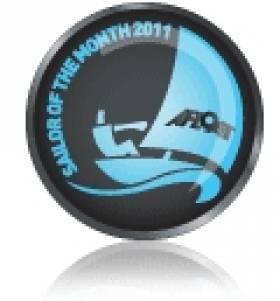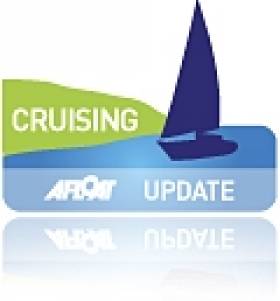Displaying items by tag: Skerries
Mermaid Championship Success for National Yacht Club's 'Tiller Girl'
#mermaid – The National Yacht Club's Jonathan O'Rourke with Carol Cronin and Alan O'Rourke in Mermaid No. 77 Tiller Girl have sailed to victory at the 2012 Mermaid National Championships in Skerries Sailing Club at the weekend. Last week's 40 boat regatta was sailed in a varitey of conditions and marked a special 80th anniversary for the clinker dinghy class. Full results available below as a pdf for download.
Of the six races O'Rourke and crew had four wins, a ninth and an eleventh place. The Dun Laoghaire trio also won a haul of class cups to boot inlcuding the Master's Trophy for helms older than a certain age! Celia No.5 Trophy for boats older than 40 years, the North Bull Cup for winning Race 3, Doreen Cup for Race 4, Rush Cup for Race 5 and Bailey Cup for Race 6.
Runner up was Skerries sailing Club's Mark Boylan with Niall Collins and Andrew Sexton sailing No. 177. Of the six races Mark and crew had three seconds, a third and two sixths.
O'Rourke's club mate Roger Bannon sailing with Kate Grimes and Robert Bannon in No. 102 Endeavour. Of the six races Bannon and crew had a win, a second, a third, a fourth, an eleventh and a disqualification.
Local Trio Lead 80th Anniversary Mermaid Nationals off Skerries
#mermaid – One of the biggest Irish one design dinghy fleets of the 2012 season has gathered in North Dublin this week to celebrate an important birthday both for the class and Irish sailing. The 80th Anniversary Mermaid Championships in Skerries has attracted 41 entries who have enjoyed very close racing in light winds, strong tides and coped with yesterday's poor visibility with dense fog rolling in from the Irish Sea. Full results to date are available for download below.
Most of the usual names are to be seen at the top of the leader board but a number of new young helms are making their impression, not the least being the consistent performance from 20 year old Mark Boylan and his young crew from Skerries sailing a boat built by his grandfather no177 "This Is It"
After 4 races Mark Boylan leads from a group of former winners including Paddy Dillon in Wild Wind no131 and Roger Bannon in Endeavour no102.
Jonathan O Rourke in Tiller Girl no 77 has recorded 2 back to back emphatic wins but a slow start in earlier races currently holds him in 5th place just behind another multiple championship winner Jim Carthy from Rush in the famous Vee no 123.
The top 3 boats are within 3 points of each other and the race on Thursday when the discard clicks in will undoubtedly have a dramatic impact on the outcome with Tiller Girl hoping to claw back ground lost earlier in the week and go into Friday with a real prospect of success in conditions she normally dominates.
Browne Wins Optimist Leinsters
#opti – The Optimist Leinster championships ran in Skerries last weekend. Day 1 saw sailors launch in rain with high winds meaning that the Regatta Fleet were shorebound on the Saturday, although 3 races were sailed in the Main Fleet. On the Sunday the forecast proved correct with light winds in the morning completely dying away, so that in the end only one race was sailed in the Junior and Senior fleets.
Winds changed so fast that only three Senior sailors managed to cross the finish line in the Sunday race before the wind died completely.
Congratulations to Sophie Browne (TBSC/RCYC) who came first in the Senior Gold fleet, Lucy Donworth (RCYC) who won the Senior Silver fleet, and to Loghlen Rickard (NYC), winner of the Junior Gold fleet, and Peter Fagan(NYC), winner of the Junior Silver fleet."
This Friday Last Day for 2012 Fingal Lifeguard Applicants
#WATER SAFETY - This coming Friday 30 March is the closing date for applications for Fingal County Council beach lifeguards for the 2012 summer season.
Lifeguard cover will be provided on Fingal beaches on weekdays and weekends 11am to 7pm from 2 July till the last week of August, depending on weather and staff levels.
Beaches and bathing places scheduled to be guarded this summer include Balbriggan (front beach), Skerries South, Loughskinny, Rush North and South Shores, Portrane (Tower Bay and The Brook), Donabate, Malahide, Portmarnock, Sutton (Burrow Road) and Howth (Claremount).
Applicants must be not less than 17 years of age on 1 May 2012. Application forms are available to download HERE.
Body Recovered Off Dublin Thought to Be Missing Fisherman
#RESCUE - The Evening Herald reports that a body recovered 14km off the coast of north Dublin on Sunday is believed to be that of a missing fisherman.
The grisly find was made by the fishing vessel Rath Eilte in the waters off Skerries. A post-mortem was set to be carried out yesterday to determine the cause of death.
Found fully clothed in black and yellow oilskins, the remains are thought to be those of a Ukrainian in his 30s, a crewman on the Kilkeel-registered Zenith who was reported missing some 14.5km off Clogherhead in Co Louth on 29 January.
Health Minister Speaks Out Against Fingal Sewerage 'Super Plant'
#NEWS UPDATE - The Minister for Health has raised concerns over a new water treatment 'super plant' planned for Fingal, amid fears that a malfunction could see huge amounts of raw sewerage pumped into the Irish Sea.
As reported in The Irish Times, Dr James Reilly echoed worries expressed by his north Dublin constituents and members of community group Reclaim Fingal Alliance, noting that the people of Skerries, Loughshinny and Rush are particularly "worried about the effects of the outfall pipe in their area".
The minister said that none of the nine sites being considered by Fingal County Council and Greater Dublin Drainage was suitable for sewerage treatment, and that any waste should be treated to "advanced levels" to make the outfall as clean as possible, thereby avoiding adverse impact on shellfish beds.
As many as 10,000 letters of objection have been lodged against the plan by campaigners including local farmers and environmentalists.
The Irish Times has more on the story HERE.
Bottlenose Dolphin Pod Seen Again Off Dublin Coast
#MARINE WILDLIFE - They were thought to have disappeared from the east coast in October after delighting wildlife enthusiasts in Dublin and Wicklow.
But concerns that one of the group had died were swept side when the pod of three bottlenose dolphins was once again spotted off Killiney recently.
The Wicklow People reports that the two adults and one juvenile reappeared almost two weeks ago, and have been seen daily "putting on great displays of leaping, breaching, and tail slapping".
Fears were that tragedy had befallen the group when two bottlenoses were seen off Skerries and Balbriggan in late October, and a juvenile was found dead in Portmarnock shortly after.
As previously reported on Afloat.ie, some 200 sightings of the dolphins between Dalkey Island and Wicklow town in recent months were validated by the Irish Whale and Dolphin Group (IWDG).
According to the IWDG, evidence suggests that the pod is now resident off the east coast.
The Wicklow People has more on the story HERE.
Pat Kelly is Afloat's Sailor of the Month for November
#SAILOR OF THE MONTH – Pat Kelly of Rush Sailing Club is the Afloat.ie/Irish Independent "Sailor of the Month" for November after his J/109 Storm - crewed by fellow-Fingallions - was celebrated as the Irish Cruiser Racer Association "Boat of the Year" at the ICRA annual general meeting in Dun Laoghaire at the weekend.
The sailors of north Fingal are on a roll these days. Back in September, Matt Davis of Skerries won our monthly award after his Sigma 400 Raging Bull retained the Irish Sea offshore championship. And another Skerries sailor, windsurfer Oisin van Gelderen, continues to be Ireland's fastest man afloat, his current official best speed being 44.23 knots.
Now it's the turn of Rush to top the podium. Not that Rush is new to successful sailing. Once upon a time, it was the top port on the east coast of Ireland for smugglers who veered into privateering and occasionally even piracy. To succeed in any of these activities, they needed fast ships and able skippers, and captains like Luke Ryan and James Mathews gave Rush its formidable sailing reputation.

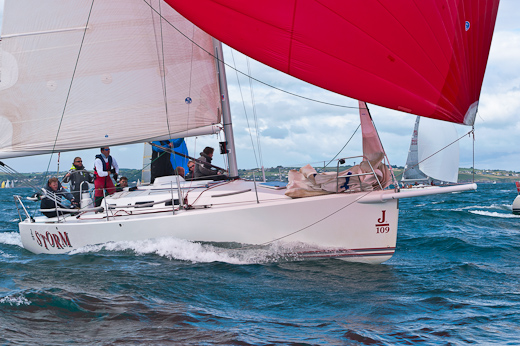
Storm was made ICRA Boat of the year last weekend and this Saturday her skipper Pat Kelly becomes Sailor of the month for November. Photos: Bob Bateman
Highlight of Pat Kelly's season with Storm was his outright class win in the ICRA Nationals at Crosshaven. Five wins in six races is the sort of performance that would get the Luke Ryan/James Mathews seal of approval. Storm was also regularly in the frame in many other major events, and had frequent success in regattas and club racing with a dedication to sailing that does her skipper and crew proud.
Pat kept his previous 30-footer in the tide-riven anchorage at Rogerstown off Rush SC's attractive south-facing clubhouse, one of the few south-facing sailing clubhouses in the entire country. However, with the bigger boat it was necessary to find a berth at Howth, and in fact Storm sails as a joint HYC/RSC entry. But the club in Howth wouldn't begrudge this success to their smaller neighbours to the north. And with their own marina in fine shape (it hosts next year's ICRA Nationals in late May), they'd be the first to agree that the only thing holding back north Fingal sailing from even greater achievements is the lack of sheltered and conveniently accessible pontoon berthing on the entire coast between Malahide and Carlingford Lough.
More from WM Nixon in the Irish Independent here
Matt Davis is September's Sailor of the Month
The welcome revival of the offshore racing programme in the Irish Sea has been steered by Peter Ryan of the National Yacht Club in Dun Laoghaire, but without the enthusiastic crew like the Skerries squad, it just wouldn't happen.
Apart from the continuous effort of keeping a frontline offshore racer and all her equipment in sound working order, the demands on personnel for time in this crowded era can be quite exceptional. The logistics are formidable, as the regular cross channel ISORA programme is based on a willingness to alternate between starting points on the Welsh and Irish coast.
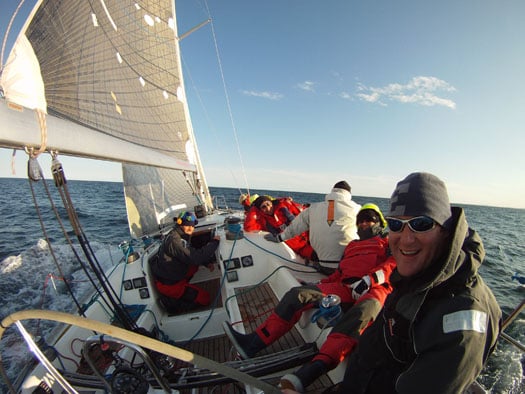
Matt Davis and crew on board Raging Bull in one of this year's ISORA races. Photo: Brian Carlin
For boats heading for an away start, it often involves an overnight passage beforehand. In the case of Raging Bull, all starts are away events, as the programme does not as yet take in Skerries. But we can hope that this will change in the future, as the nucleus of a Fingal offshore racing group develops around the Davis success.
With the summer of 2011's uneven weather, Raging Bull's crew had to be fit and ready to take full advantage of their boat's proven ability in rugged weather, while at the same time managing to turn in a respectable performance in light airs.
For the first time, the biennial Dun Laoghaire-Dingle race was recognized as an ISORA event, and Davis and his crew revelled in it. For much of the race they were the only boat mounting a significant challenge to the pace setter, Martin Breen's Reflex 38 Galway Harbour. Though the Skerries boat had to be content with the runner-up slot to the Galway boat in Dingle, they were first of all the ISORA participants, a top score which stood well to them when they continued with the Irish Sea programme right up until mid-September. Despite the limited size of the harbour, the maritime spirit of Skerries is manifesting itself in many areas of sailing, and Matt Davis's achievement is typical of the special Fingal fervour.
More on Matt's 2011 victory in Autumn Afloat magazine out next week!More ISORA News here
Forty Boats Prepare for Liffey Cruise
The boats are mostly modest sailing yachts with some motor cruisers, typically eight to twelve metres long with up to six people aboard. They come from ports on the East coast of Ireland between Arklow and Skerries.
The sailors will spend the afternoon visiting other boats, renewing friendships and comparing notes. Some will use the opportunity to explore the city centre from this unusual perspective.
There are organised visits to the Jeanie Johnston and the Guinness Storehouse. A special attraction this year is a guided tour of the docks in an inflatable boat, by Sea Safari.
In the evening the whole group, about a hundred people, will gather for dinner in a nearby hotel. Formalities will be limited to a review of the season in general and the summer cruise in Strangford Lough, but the party is likely to continue until late.
Most sailors will spend the night aboard their boats. On Sunday morning commodore Derek Harris will say mass aboard the Jeanie Johnston. The bridges will open once more at noon, and the fleet will disperse to their home ports.
This annual event is organised by the Cruising Association of Ireland with the co-operation of the Dublin Docklands Development Authority and Dublin Corporation.
The Cruising Association of Ireland supports and represents the cruising community in Ireland, both power and sail (www.cruising.ie). Contact Derek Harris 087 6740334 [email protected], or Simon Parker 0872497859 [email protected]





























